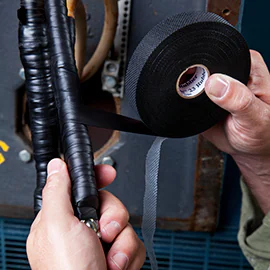How to Use Amalgamating Tape A Comprehensive Guide
Amalgamating tape is a versatile and highly effective adhesive product commonly used in electrical work, plumbing, and various DIY projects. Known for its excellent insulating properties and ability to create a solid seal, this self-fusing tape offers a reliable solution for a range of applications. In this article, we'll explore what amalgamating tape is, its uses, and a step-by-step guide on how to properly apply it.
What is Amalgamating Tape?
Amalgamating tape is a type of rubber-based or PVC tape that does not have any adhesive on its surface. Instead, it relies on the unique property of self-fusion; when you stretch it and apply pressure, the layers of the tape bond together, creating a watertight and airtight seal. This makes it especially useful in environments where moisture exposure is likely or where electrical insulation is crucial.
Uses of Amalgamating Tape
Amalgamating tape has a wide array of applications
1. Electrical Insulation It is extensively used in electrical work to cover exposed wires and connections, providing a protective barrier against moisture and corrosion.
2. Plumbing Repairs This tape can seal leaky pipes and joints, preventing water damage and ensuring that plumbing systems function effectively.
4. General DIY Projects From repairing garden hoses to bundling wires, amalgamating tape is a handy tool for various home improvement tasks.
amalgamating tape how to use

How to Use Amalgamating Tape
Using amalgamating tape is straightforward, but following the right method will ensure optimal results. Here’s a step-by-step guide
1. Clean the Surface Before applying the tape, ensure the surface is clean, dry, and free of dirt, grease, or dust. This allows for better adhesion and bonding of the tape layers.
2. Cut the Tape Cut a piece of amalgamating tape to an appropriate length, usually enough to wrap around the area needing coverage two to three times.
3. Stretch the Tape Begin wrapping the tape around the target area while stretching it slightly. The key to effective bonding is to stretch the tape as you wrap; this activates its self-fusing properties.
4. Overlap Layers When wrapping, overlap each layer by about half of its width. This overlapping ensures there are no gaps, allowing for a complete seal that can withstand moisture and environmental factors.
5. Finish the Wrap Continue wrapping until the area is thoroughly covered, then press down the last portion firmly to secure it in place. The tape will fuse itself together, creating a strong, cohesive bond.
6. Allow Time to Cure After application, give it some time to cure. While amalgamating tape fuses quickly, allowing it to set ensures maximum effectiveness.
Conclusion
Amalgamating tape is an invaluable asset for professionals and DIY enthusiasts alike. When used correctly, it provides exceptional insulation and sealing properties that can withstand various conditions. By following the steps outlined above, you can ensure effective and lasting results for your projects, ultimately making your repairs and installations more reliable and efficient. Whether you’re working in electrical, plumbing, or general maintenance, having amalgamating tape in your toolkit is a wise choice.
-
XIANGFAN Rubber Tape-Ultimate Solutions for All Your Insulation NeedsNewsJun.24,2025
-
XIANGFAN Rubber Tape-Protection for Industrial and Residential ApplicationsNewsJun.24,2025
-
XIANGFAN Rubber Tape: Superior Safety and Sealing for Demanding EnvironmentsNewsJun.24,2025
-
XIANGFAN Rubber Tape: Reliable Solutions for Every Electrical ChallengeNewsJun.24,2025
-
XIANGFAN Electrical & Industrial Tape: Powering Reliability Across IndustriesNewsJun.24,2025
-
XIANGFAN Electrical & Industrial Tape: Excellence in Every ApplicationNewsJun.24,2025
